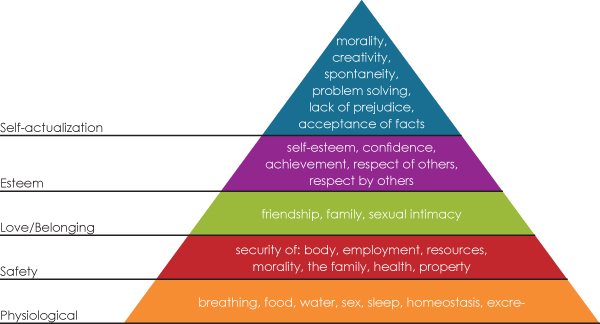The following discussion is concerned with understanding how we use motivation to achieve, rather than (the motives of) why we do what we do. The latter requires factoring our many beliefs and who we are as individuals; a conversation that would distract us from this (more narrow) purpose. That being said, to truly reach our potential, we are served to learn, understand and factor, why we do what we do. But that can come later. This discussion is only intended to inspire the gathering of knowledge and apply understanding, skills and resources to pursue potential through achieving goals.
Since this department covers contiguous material that spans several months, I will deliver it in eight parts: Motivation, Goals, Priorities, Planning, Organizing, Initiative, Obstacles and Navigation. Please remember philosophy is not always inspirational in knowing. Inspiration is found with the imagined or practical application of ideas. And conceptually, this material will have more relevancy as a whole, so please be patient while we put the parts together. Combined, these principles provide the initial tools that built civilization and culture and as applied, determine the quality of our lives.
Disclaimer
I offer acknowledgement, with gratitude and respect to all who have paved the road upon which we tread. Philosophies of motivation and empowerment have been documented and evolved throughout history. These are not original concepts, rather interpretations of exposure to history, philosophy, psychology and human behavior. Like each of us, I am influenced by many people and have drawn from all available forms of inspiration and personal experience. I share these perspectives with respect to all who have influenced my understanding and beliefs.
The common definitions are;
Motivate: to provide with a motive
Motive: a need or desire that causes a person to act
Motivation is the psychological initiative that stimulates action toward a goal and evokes and nurtures relative behaviors; a compulsion that drives or reinforces action toward a desired purpose or goal. It is also response to our specific physiological needs such as eating and sleeping. Motivation can be physiological, subconscious, behavioral, social, and/or cognitive in nature. It is part of our basic compulsion to sustain well-being, minimize pain and maximize pleasure.
Motivation is often divided into two types: extrinsic (external) and intrinsic (internal). Extrinsic motivation describes goal-oriented actions focused on outcome, rather than pleasure or experience. These motivations are stimulated from outside the individual. Competition is a good example because it focuses on the performance for the sake of winning rather than intrinsic rewards of competing. Social status, money, achievement and punishment are also examples.
Intrinsic motivation describes motivations that are compelled by self-enjoyment or taking pleasure in activity. They are derived from within an individual as opposed to outside influence, pressure or force. These motivations are driven by how we feel. Personal preferences such as style, color, hobbies or developed tastes are examples.
Motivational Theories
Need Hierarchy – The psychologist Abraham H. Maslow developed the theory "Hierarchy of Human Needs." This theory provides that needs have priority and unsatisfied needs influence behavior, while satisfied needs do not. A person advances through these priority of needs only after the lower level need is minimally satisfied. The more progress through the hierarchy, the more individuality, creativity, humanness and psychological health a person exhibits.
Approach versus Avoidance – Approach motivation is energy focused on engaging a positive experience. Avoidance is energy directed to avoid a negative experience. This is also known as the Pleasure/Pain theory. The consensus is, as compared, approach motivations are not as compelling to us as avoidance motivations. All things being equal, most of us would choose to avoid pain before we would choose to engage pleasure. We instinctively anticipate losses to have a more intensive emotional impact than equal portioned gains. People will often take bigger risks to avoid losses than to realize equal gains.
Incentive – Incentive theory describes an incentive (tangible or intangible) being provided to direct or affect behavior, intending to repeat the desired behavior. Studies suggest when a person receives immediate reward, the effect on behavior is greater and decreases as a reward delay lengthens. Further, repeating this action-reward conditioning can easily cause the action to become habit.
Reinforcement theory differs slightly from the simpler concept of incentive. Reinforcement is any stimulus change following a response that increases the future frequency or magnitude of that response. Both incentive and reinforcement are also known as positive reinforcement. Positive reinforcement describes when the frequency or magnitude of a response is increased due to continuous pursuit (momentum). Negative reinforcement describes removal of an aversive stimulus following a preferred response, such as in punishment. These theories deal with motivation as influenced more by environmental events.
Applying incentive and reinforcement theories are often a complex consideration. Not every person responds to the same stimuli or to the same degree. Also, over time, the effects are often diminished so consistency is a factor. And, since it can be habit forming, it is not uncommon for this initiative to develop negative results contrasting intent.
Intrinsic, Basic Desires
Professor Steven Reiss reports from a study that documents a proposed theory defining 16 basic desires that drive human behavior. They are:
- Acceptance, the need for approval
- Curiosity, the need to learn
- Eating, the need for food
- Family, the need to raise children
- Honor, the need to be loyal, values/clan/ethnic group
- Idealism, the need for social justice
- Independence, the need for individuality
- Order, the need for organized, stable environments
- Physical activity, the need for exercise
- Power, the need for influence of will
- Romance, the need for sex and for beauty
- Saving, the need to collect
- Social contact, the need for friends/relationships
- Social status, the need for standing/importance
- Tranquility, the need to be safe
- Vengeance, the need to strike back and compete
Behavior
There are two primary models influencing behavior. Motive or motivation is understood to be the process that leads to the forming of intent. Volition describes the process that leads from intention to action. Both processes require conscious efforts. Motivation and volition also refer to the setting and the pursuit of goals. Self-efficacy exemplifies motivation and volition. It incorporates developing intent, forming plans, initiating and monitoring results. This is where the rubber meets the road, so to speak – for a concept to become reality.
Goals
Goal setting embraces individual motives and initiative to achieve defined results through application. It is extrinsic in nature with the reward of achievement being the primary motivating factor. We develop goal setting like any skill; with practice and application. For sake of perseverance, it is wise to build on small successes with short-term goals rather than immediately tackling long-term goals. Goals should be specific, measurable, and realistic. All things considered, a goal would not be too difficult or easy, providing challenge while inspiring initiative.
Practical Application
Memorize, document and organize your understanding of these basic principles. Each of the theories discussed apply to us at different times, to different degrees. Spend time learning and understanding your motivations and how you can use them. Begin by becoming aware and recognizing your motivation in conceiving and pursuing goals. Define and document circumstances where you have used, and want to use motivation and volition to create results.
In the coming issues, we will discuss seven more tools of empowerment. Understanding and managing your motivation can empower you to set goals, plan, initiate and navigate to desired result. Motivation lays the foundation to build on. Goals (next month's topic) will help us establish the objective of what to build.
 William Strunk is the Publisher of DERMASCOPE Magazine, Founder of WES Publishing Co., Founding Partner with Avalon Media Group and a Partner with the International Congress of Esthetics & Spa. As an entrepreneur for over 30 years, an author and lecturer, Strunk conducts motivational seminars and results oriented workshops on successful business practices. Having started his first business as a teenager, he shares successful behavioral practices that are not taught in business schools. Rather, learned from a lifetime devoted to motivational training and developing relationships with hundreds of other successful entrepreneurs.
William Strunk is the Publisher of DERMASCOPE Magazine, Founder of WES Publishing Co., Founding Partner with Avalon Media Group and a Partner with the International Congress of Esthetics & Spa. As an entrepreneur for over 30 years, an author and lecturer, Strunk conducts motivational seminars and results oriented workshops on successful business practices. Having started his first business as a teenager, he shares successful behavioral practices that are not taught in business schools. Rather, learned from a lifetime devoted to motivational training and developing relationships with hundreds of other successful entrepreneurs.
